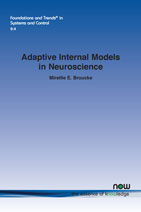Adaptive Internal Models in Neuroscience
By Mireille E. Broucke, University of Toronto, Canada, broucke@control.utoronto.ca
Abstract
This monograph examines in mathematical terms an open question in neuroscience on the function of the cerebellum, a major brain region involved in regulation of the motor systems, speech, emotion, and other cognitive functions of the body. Reasoning from the perspective of control theory, we make a hypothesis that the primary function of the cerebellum is disturbance rejection of exogenous reference and disturbance signals. This brings to the fore the internal model principle of control theory: that any good controller must include a model of its environment.
The monograph is structured around a pursuit of the validity of this hypothesis. Given the system level architecture and the measurement structure of the cerebellum, is disturbance rejection mathematically feasible? Second, is a disturbance rejection interpretation consistent with experiments? Specifically we investigate the possibility that the cerebellum provides adaptive internal models of signals generated by the environment. After a brief historical overview of computational theories of cerebellar function and of the relevant parts of control theory in the area of regulator theory, we carry out a more or less chronological review of subjects in control theory that impinge on our investigation.
We begin with classical regulator theory with its characteristic features of a known plant and known frequency content of disturbance and reference signals. We then pause to examine classical regulator theory from the perspective of modeling the cerebellum, finding that several aspects are not well suited to this endeavor. Foremost is the unrealistic assumption that the plant and exosystem parameters are apriori known. More subtle issues arise from the fact that classical regulator theory developed in a setting where output and error measurements are regarded as persistent, an assumption not valid in the brain. Next, we review adaptive control theory, organized in terms of error models. The main control theoretic tools appear in Section 5, as a synthesis of classical regulator theory and adaptive control, where we present several adaptive internal model designs.
To test our hypothesis on cerebellar function, we apply adaptive internal model designs to several motor systems regulated by the cerebellum. These include the slow eye movement systems: the vestibulo-ocular reflex, gaze holding, smooth pursuit, and the optokinetic system. We also study discrete time behaviors regulated by the cerebellum: the saccadic eye movement system and, more generally, visuomotor adaptation. The results from these modeling studies suggest that an interpretation of cerebellar function in terms of disturbance rejection is compelling, with the potential to provide a unifying framework to explain how the cerebellum can contribute to so many different systems in the body. The monograph concludes with suggestions for future research directions.
Adaptive Internal Models in Neuroscience
One of the open questions in neuroscience is the function of the cerebellum, a major brain region involved in regulation of the motor systems, speech, emotion, and other cognitive functions of the body. In this monograph the author makes and tests a hypothesis that the primary function of the cerebellum is disturbance rejection of exogenous reference and disturbance signals. In achieving this goal, the author provides a brief historical overview of computational theories of cerebellar function and of the relevant parts of control theory in the area of regulator theory, and then presents a chronological review of subjects in control theory related to the hypothesis.
The author begins with classical regulator theory and highlight some aspects that are not suited to the modeling of the cerebellum. Then adaptive control theory is reviewed in terms of error models. To test the hypothesis on cerebellar function, the author applies adaptive internal model designs to several motor systems regulated by the cerebellum. These include the slow eye movement systems: the vestibulo-ocular reflex, gaze holding, smooth pursuit, and the optokinetic system. Finally, discrete time behaviors regulated by the cerebellum are investigated. In all, this monograph provides a unifying framework to explain how the cerebellum can contribute to so many different systems in the body.
This monograph is an important comprehensive study of modeling the cerebellum using control theory techniques. It will be of interest to neuroscientists and control theorists working on understanding the function of the human brain.
